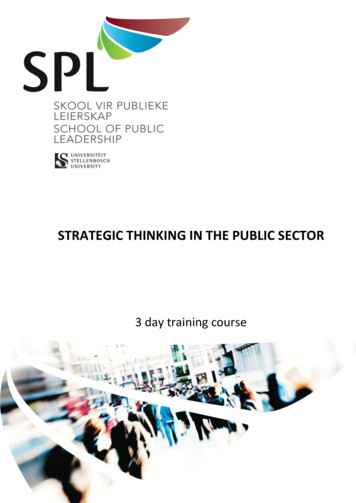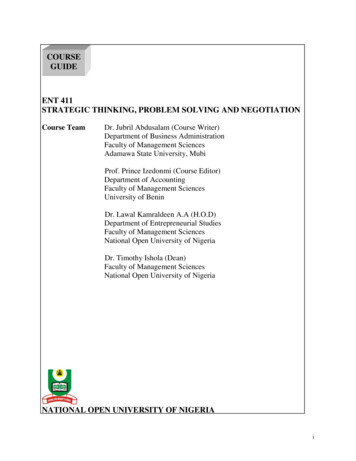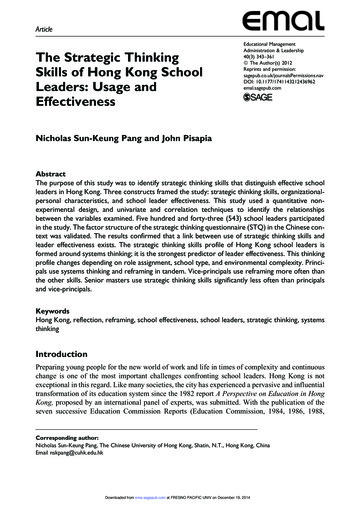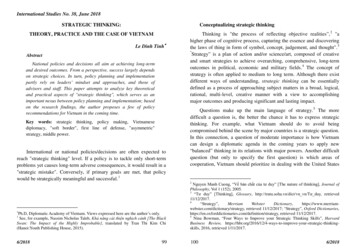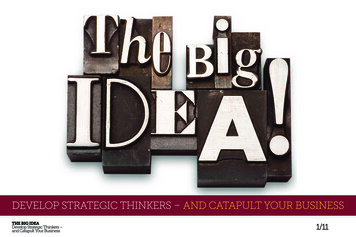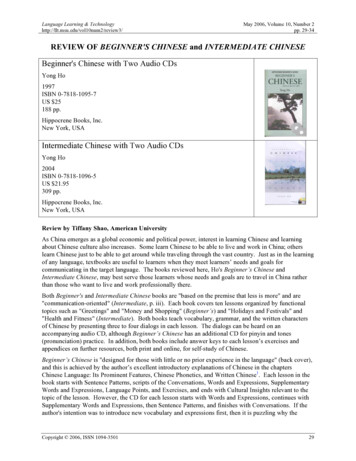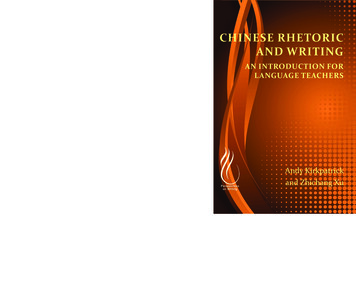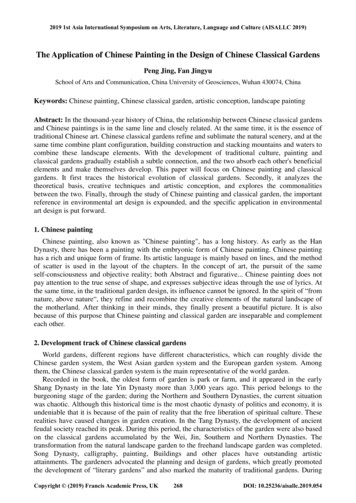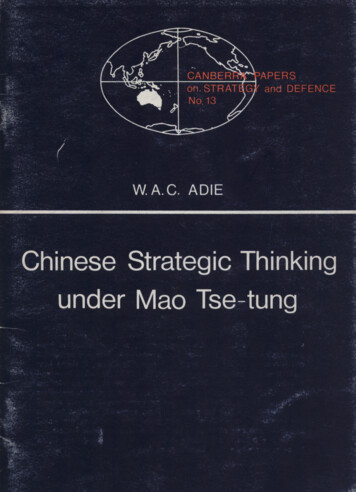
Transcription
No. 13Chinese Strategic Thinkingunder Mao Tse-tung
This paper traces the development of the military and politicalstrategies of the Chinese Communist Party, as systematised in MaoTse-tung’s Works and other writings attributed to him and as carriedout in practice during the struggle for power in China. It shows howthese strategies and tactics are applied, in suitably modified form andat different levels of sophistication, to the conduct of foreign relationsby the Chinese People’s Republic. The author argues that, regardlessof changes in the hierarchy, the Peking government’s actions abroadwill continue to reflect the politico-military approach ascribed to MaoTse-tung, although much of its past policy has now been repudiatedas due to distortion of Maoism by deviationist subordinate leaders.This is a welcome addition to the literature on contemporary Chinaby an author with a wide knowledge of Asian affairs.
CANBERRA PAPERS ON STRATEGY AND DEFENCE13Strategic & DefenceStudies Centre,RSI'uCS,r ! i s : Australian National University,P.O. Box 4,Can: erraA.C.T.2600i AUSTRALIAN NATION,»I — "R---- 7, j A n o o e F - r.J r .a*"-’IVETS I TVISTUDIES c e n t r e I
Chinese Strategie ThinkingunderMao Tse-tungW. A. C. ADIEA publication ofThe Strategic and Defence Studies CentreAUSTRALIAN NATIONAL UNIVERSITY PRESSCANBERRA 1972
William Andrew Charles Adie 1972This work is copyright. Apart from any fair dealing for thepurposes of private study, research, criticism, or review, aspermitted under the Copyright Act, no part may be reproducedby any process without the written permission of the publisher.Text set in Times Roman.Printed in Australia by R iall Print Pty Ltd282 Bay Street, Port Melbourne, Vic. 3207National Library of Australia Card no.and ISBN 0 7081 0036 8Library of Congress Catalog Card no. 72-85441
CHINESE STRATEGIC THINKING UNDERMAO TSE-TUNGthought’ we have all heard about is essentiallyall military thought— that is, it applies essentially military thinking toall sorts of problems, from industrialisation of a large backwardcountry to the conduct of international affairs. It is, of course, militarythinking of a special kind.In Mao’s thought military and political affairs form a continuum.Among western leaders, perhaps only General de Gaulle was in asimilar position to master both .1 Mao likes to quote Lenin’s sayingthat ‘War is the continuation of politics’, and Mao himself adds, ‘waris the politics of bloodshed and politics is war without bloodshed’ ;2 inthe course of his quarter-century of revolutionary struggles he and hiscomrades learnt many lessons on the art of survival, which were paidfor in a great deal of blood. Mao also quotes Marx’s idea that the‘cell’ or unit of capitalist society is a cash transaction; Clausewitz toowrites that war may be compared to commerce and battles to a trans action .3 Mao often expresses a similar idea; although he does notT h e ‘M ao T s e - t u n g ’s1 The introduction to General de Gaulle’s book Le Fil de L’epee containspassages which could have been written by Mao; so do several of his otherworks, especially his memoirs — of war.2 Little R ed Book, 2nd ed., Peking, Foreign Language Press (PFLP), 1968,pp. 58-9.3 Carl von Clausewitz, On War, trans. J. J. Graham, London, 1949, Vol. I,p. 121.
2expressly say so, he seems to feel that the experience or life of anindividual, the history of a group, etc. is to be understood as a seriesof encounters or transactions, that is to say, the concrete expressionsof latent ‘contradictions’ {Maodun). In Chinese the word literallymeans spear and shield or offence and defence— as Mao says, allwarfare is based on developments of these two elements, and if youthink of them as stimulus and response or action and reaction thereis evidently the germ of an intelligible theory here, at least in thesphere of human relations and social science. Generalising ratherbroadly, one can say that the tendency in traditional Chinese thoughthas been to try and apply social thinking to the sphere of naturalscience, while since the Greeks our western thought has tried toapply the rigid categories of mathematics and the natural sciences tosocial problems.4For Mao, then, life and warfare are the same thing— a series oftransactions, encounters, or bouts between unequal quantities; ‘peaceand war are characterised by identity under certain conditions’. Thisis perhaps why Mao calls his doctrine the algebra of revolution: itbrings an unknown quantity into correlation or balance (temporarybalance) and therefore makes it known. (Knowledge can only beacquired through struggle; ‘if you want to know the taste of a pear,eat it, if you want to know how to make revolution, make revolution’.The Chinese people obtained their ‘knowledge of imperialism’ throughstruggle, and so on.)Some writers, both Chinese and foreign, have argued there is aparticularly Chinese logic or way of thinking, in some mysterious waydifferent from what westerners and others accept as normal reasoning.5Whether or not it may be characterised as ‘pre-scientific’ thought,Mao’s thought evidently works. It is based not only on the longexperience of the ‘warring kingdoms’ and ‘three kingdoms’ summedup in Chinese history, but also on his own quarter-century of revolu tionary experience. The thinking behind the game of Chinese ‘encircle4 In fact the Thought of Mao Tse-tung has much in common with the preSocratic (or rather pre-Platonic) philosophers, especially Heraclitus. In his poem‘Swimming’ Mao quotes a tag from Confucius about how ‘all things are inperpetual motion’. In his book mentioned above, de Gaulle quotes the identicalsaying of Heraclitus in the original Greek: ‘a la guerre comme ä la vie, onpourrait appliquer le “panta rhei” du philosophe grec’, op. cit., p. 16. Cf. H.Diels, Fragmente der Vorsokratiker, Berlin, 1952, p. 171: Heraclitus, Fragment 91.5 See for example I. A. Richards, Mencius on the Mind, London, Kegan Paul,1932, pp. 3 and 128; Chang Tung-Hsun, ‘A Chinese Philosopher’s Theory ofKnowledge’ in Yenching Journal of Social Studies, Peiping, Vol. I, N o, 2,January 1939, pp. 155-91.
3ment chess’ (Japanese gö) is also an important element in Mao’sapproach, and he refers to it explicitly in his works.6Mao’s ‘military thought’— or rather his unified politico-militaryapproach— is important not only because of its role as a model forpeople’s wars or Chinese-style insurgencies in individual countries(especially in Asia, Africa, and Latin America) but also because thesame approach applies to the handling of China’s affairs on the worldscale. Mao has a genius for simplification, and his ‘thought’ applies afew extremely simple, commonsense ideas to problems of various levelsof complication. At most of these levels, it does seem to have worked.To take one of his phrases, then, ‘where did his correct ideas comefrom?’First, we have to remember that Mao Tse-tung is not just an all purpose inflatable cult object as he seems to be in some of the picturesin the Chinese newspapers; he is a human being and his individualcast of mind or mentality is very important. Jerome Chen’s excellentbiography does not discuss his psychology. The book on his politicalthought by Stuart Schram partly remedies this, and works by RobertJ. Lifton, Lucian Pye, Richard Solomons and others should be borne inmind in considering the origins of Mao’s thinking.7 The consensusof opinion among such writers is that Mao is fired with the idea ofmilitary heroism, and that he identifies himself with ‘Robin Hood’figures in literature. But some other, Chinese, writers see things from aslightly different angle. Professor Tang Tsou says that the Maoists’mentality is ‘the paradoxical combination of a deep sense ofinsecurity and a tremendous confidence in ultimate victory’. A similarpattern emerges from a perceptive book written by a refugee fromMao’s China over the signature of ‘Mu Fu-sheng’. 8 This ambivalentoutlook is expressed clearly in Mao’s famous theory that imperialistsand his other enemies are ‘paper tigers’ who should be feared tacticallybut despised strategically. Others would say that the fanaticismshown by low-grade Maoists is the kind which overcompensates for6 See Scott A. Boorman, The Protracted Game—A Wei-ch’i Interpretationof Maoist Revolutionary Strategy, New York, O.U.P., 1969; Arthur Smith, TheGame of Go, Rutland, Vt, Charles E. Tuttle, 1956 (first published 1908).7 R. J. Lifton, Revolutionary Immortality, London, Weidenfeld & Nicolson,1969; Lucian Pye, The Spirit of Chinese Politics, London, MIT Press, 1968;R. Solomon, ‘Communication Patterns and the Chinese Revolution’, ChinaQuarterly, No. 32, 1967.8 Tang Tsou, America’s Failure in China 1941-50, Chicago, Univ. of ChicagoPress, 1963, p. 578; Mu Fu-sheng, The Wilting of the Hundred Flowers, LondonHeinemann, i962.
4doubts and anxiety; reading some of the material, one gets the mentalpicture of the archetypal Maoist as a man swimming desperatelybecause he has been thrown in the water. The aim of swimming is,after all, usually to reach dry land. Mao always says people areforced to struggle, but sometimes one has the impression that thestruggle (and the swimming) can become an end in itself and theultimate aim of restored peace and security drops out of sight.9If Mao has a heroic and activist turn of mind, what then, is theobject of his exercise? We must remember that Mao comes fromHunan province, the ‘civil war belt’ of China, where the populationwas afflicted with experiences similar to those of Germany, say, inthe Thirty Years’ War. Furthermore, there was an unusually positiveoutlook among the elite of the province which had produced famouswriters and politico-military leaders, as a result of which the ideawas in the air that something can be done, that people and societycan be changed10 and foreigners can be dealt with.In the days of Mao’s youth self strengthening of China was theorder of the day, and for Mao this was to be achieved by activity, notpassivity— as it were by sweating out the alien or polluting elementswhich were held responsible for the disaggregated, weak condition bothof China and of the units of Chinese society right down to theindividuals— the malady diagnosed by Sun Yat-sen as disintegration‘like a sheet of sand’. The cure sought was a ‘cement’ such asnationalism.The first known published work of chairman Mao is his essay of1917 On Physical Training in which he recommended that the Chinesepeople toughen themselves with a set of gymnastic exercises. In thisessay he already foreshadowed what was to become the central idea9 I care not that the wind blows and waves beat.It is better than idly strolling in a courtyard.Today I am free! It was on a river that the Master saidThus is the whole of nature flowing.(From Mao’s poem, ‘Swimming’ [in the Yangtze], PFLP, 1958, p. 28.)10 The famous Hunanese philosopher Wang Fu-Chih (1616-92) expoundedthe ancient Book of Changes (Chou I) and argued that ‘There is not a singlepart of human nature already shaped that cannot be modified’: see Jerome Chen,Mao, New Jersey, Prentice Hall, 1969, p. 2. Mao himself has written: ‘Althoughwe are determined by nature, we are also a part of nature. Hence, if Naturehas the power to determine us, we also have the power to determine Nature.’This is the idea underlying the Book of Changes as well as the Little R ed Book.See Hellmut Wilhelm, Change: Eight Lectures on the I Ching, Routledge &Kegan Paul, London, 1960 [1961], p. 22.
5of his thought, the importance of physical and mental remouldingthrough ‘struggles’. ‘If our bodies are not strong’ he says,we will be afraid as soon as we see enemy soldiers, and then howcan we make ourselves respected? If we wish to make physicaleducation effective we must influence people’s subjective attitudesand stimulate them to become conscious of physical education . . .physical education really occupies the first place in our lives . . .the principal aim of physical education is military heroism;but it also enhances knowledge and harmonises the feelings. There isno contradiction between robust health and mental capacity, says Mao;on the contrary, his essay concludes, Confucius and Buddha lived toa ripe old age and ‘as for Mohammed, he subjugated the world holdingthe Koran in his left hand and a sword in his right’.Mao’s thinking gradually evolved, perhaps more unconsciously thanconsciously, from the concept of strengthening and perfecting himselfto that of securing autonomy for his native province Hunan, and thenof liberating China, and the world, by getting rid of whatever it isthat somehow pollutes and weakens them. The Chinese started toevolve nationalist thought by blaming the Manchu dynasty for theirproblems but, once the Manchus had been overthrown in 1911, thingswere no better and it was necessary to find other scapegoats such as‘alien class elements’ to be expelled or purged. Running throughMao’s thought there is also a feeling of anxiety that if you stop pushingon the wheel of history and getting rid of the dangerous thoughts,ghosts and demons, the wheel will turn back; the bourgeoisie is tryingto remould the world, and ultimately you, in its own image; so we( ‘the people’) must continue to remould the world in our own image.Here you have the idea of an anti-world of outlaws or a counter culture which starts off in a small way but one day will becomedominant.I have dwelt on these psychological aspects because the so-calledthought of Mao is more an attitude of mind or a spirit than a formaldoctrine. As such it cannot really be taught— you can be convertedto it or absorb it by a sort of induction, by dint of going through themotions; as Mao says, we learn to swim by swimming. This is adevelopment on to a higher level of the original idea of movementor exercise as drill; the famous Little Red Book bears about as muchrelation to real Maoism as shouting ‘down, crawl, observe, fire’ does tofighting a real battle. In the ritualised ‘battle drill’ of World War II,soldiers in training were taught to shout these phrases rather in thesame manner as the Red Guards shout ‘dare to act, dare to win’ etc.
6and wave the Little Red Book. They do so to internalise a patternof behaviour.Incidentally, there are two different Little Red Books already—one contains favourable references to Liu Shao-ch’i and the later oneomits them. This may serve to remind us that Chinese military andpolitical thinking in the era of Mao Tse-tung has not, after all, allbeen done by Mao and there have been divergent strands in it. Theso-called ‘erroneous military line’ or bourgeois military line was imputedto successive senior officers, including Chiefs of Staff, who remainedclose to military affairs while the other leaders of the Chinese Com munist Party moved on to apply their guerrilla experience to civiliantasks. In this paper I shall have to concentrate on Lin Piao’s versionof chairman Mao’s thinking as expressed in the doctrine of people’swar.11A case can be made out that during the sixties the application ofMao’s thought was distorted (1) according to the line attributed toLiu Shao-ch’i, by the attempt to turn China not into a Mecca of worldrevolution but another Moscow, complete with international frontorganisations, pro-Peking communist parties and all the rest of Moscow’sComintern-originated apparatus, modified for Chinese use, and (2)by the erroneous militaristic line, which will probably have beenattributed to Marshal Lin Piao by the time this goes to press. Thismay be summed up as the application of an oversimplified, drill ser geant’s Maoism to foreign as to internal affairs, especially after theoutbreak of the Cultural Revolution, reflecting the takeover of func tions normally performed by civilian specialists in many fields by anuneasy combination of ultra-leftist activists and more pragmatic militaryand security personnel. The facts are obscured by the habit of those inpower of combining under one opprobrious term such as ‘charlatanslike Liu Shao-ch’i’ groups whose deviations were quite different (seebelow, pp. 23 ff.). But even those purged for these alleged errorsactually shared the basic assumptions and outlook summed up in theaccepted canons of Mao’s thought, the differences having arisen overtechnical and personal issues.ORIGINS OF THE TECHNIQUE OF PEOPLE’S WART h e origins of the people’s war may be traced back to the periodof the first and second revolutionary wars in China (1927-35). There11 Since this was written, I have heard that, after the fall of Lin Piao, all theLittle Red Books were withdrawn and a new version put out, minus theintroduction in his handwriting.
7are two main elements: social revolution and nationalist resistance,in that order.Mao at first began to develop into a student or intellectual revolu tionary, alienated from the common people. In the tradition of theintellectuals of his time he began by despising manual labour andthose who performed it, but he was converted by the experience of apeasant uprising in his native province of Hunan. The experience ofidentification with an overwhelming outburst of collective wrath con vinced him that he had found the source of strength that China needed.A psychologist might explain Mao’s success in terms of the factthat the problems of his personal life somehow coincided with those ofthe Chinese people as a whole, most of whom, of course, were andstill are peasants; it is known that Mao preferred his mother to hisfather and sided with the local poorer peasants whom the latter haddealt with unjustly. The young Mao read voraciously, especiallythe traditional romances about heroic generals and Robin Hood-typebandits which form the subject-matter of so many Chinese operas andpicture books. But after he joined the Chinese Communist Party,started by such intellectuals as Li Ta-chao and Chen Tu-hsiu, hisimprecise feelings of revolt against injustice began to change. In the1917 essay he had praised Germany and Japan for their militarism;now he began to write about workers and peasants; but in the earlytwenties, under the influence of Li Ta-chao, he tended to considerthat the Chinese were a proletarian nation, and the real class strugglewas on a national scale, between the Chinese and other non-whitepeoples and the white oppressors. The corollary of this line was thateven merchants could be a leading force in the national revolution,and Mao in fact collaborated actively with the Kuomintang in thisperiod.It was in 1925 that Mao began to realise that the peasantry mustprovide the motive force of China’s revolution, and in 1927 he wrotehis famous Report on the Peasant Movement in the province of Hunan,which showed that he had discovered the answer to the feeling ofimpotence which had for so long afflicted the intelligentsia of thecountry. Ch’en Po-ta’s authoritative commentary on Mao’s Reportcalls it ‘one of the best expressions of the essential ideology of thefinest people ever known in Chinese history’. Mao himself called thepeasants’ revolt ‘a marvellous feat which has never been achievedin the last forty or even thousands of years’; the force of their attackwas like a hurricane; those who submitted to it survived, and thosewho resisted it perished. It was an excellent thing, said Mao, thatthe peasants should ‘go too far to right a wrong’. ‘To put it bluntly,
8it was necessary to bring about a brief reign of terror in every ruralarea’, in order to overthrow the political authority of the gentry andlocal bullies, and of the county magistrate and his bailiffs, and theclan authority of the elders and ancestral temples, the theocraticauthority of the city gods and local deities, and the masculine authorityof husbands over women. ‘A revolution is not the same as invitingpeople to dinner or writing an essay, or painting a picture or doingfancy needlework . . . if the peasants do not use the maximum of theirstrength, they can never overthrow the authority of the landlordswhich has been rooted for thousands of years’. The Hunan peasantrevolt of March 1927 was soon to be followed by the autumn harvestuprising of September the same year in which Mao was involved. Thefailure of this operation made Mao realise the major mistakes in thepolicy of the Central Committee of the Chinese Communist Party atthat time: (1) they expected that there would be a countrywideuprising which would be over in a fairly short time; (2) the fightingwould be carried on by the ‘armed masses’, whatever that may mean,and not by organised military units; and (3) the urban proletariatwould be the decisive element although they constituted a minuteproportion of the Chinese population.The lessons Mao derived from the experience of the initial defeatwere that the fighting had to be carried on by organised units; theRed Army, the countryside and the peasantry would play the mainrole; and the war would be of a protracted nature, carried on fromrelatively firm bases, avoiding the ‘mentality of the roving insurgents’which had hitherto characterised peasant revolts throughout Chinesehistory. These ideas arose naturally from historical accidents andthe logic of the situation and were generalised into a principle later;for example, the original band which took refuge on the Chingkanmountain consisted largely of troops, from units defeated in the attackon the city of Changsha, along with a number of miners, bandits, andother uprooted people, elements declasses or lumpenproletariat in theMarxist jargon. It was this very factor that favoured their ‘remoulding’into indoctrinated military units. Mao summed up the lessons of thisperiod in his famous 16-character formula, underlined in the followingcitation from a work he wrote in 1930.Ours are guerrilla tactics. They consist mainly of the following points:‘Divide our forces to arouse the masses, concentrate our forces todeal with the enemy.’‘The enemy advances, we retreat; the enemy camps, we harass; theenemy tires, we attack; the enemy retreats, we pursue.’‘To extend stable base areas, employ the policy of advancing in
9waves; when pursued by a powerful enemy, employ the policy ofcircling around.’‘Arouse the largest numbers of the masses in the shortest possibletime and by the best possible methods.’ These tactics are justlike casting a net; at any moment we should be able to cast it ordraw it in. We cast it wide to win over the masses and draw it in todeal with the enemy.12With the outbreak of the anti-Japanese war (1937-45) and theestablishment of the united front with Chiang Kai-shek’s nationalists(KM T), Mao developed his doctrines of mobile and positional war fare and the theory of the three stages, developing on a larger scale theoriginal 16-character formula.13Before studying this development we must first consider the specialenvironment of the Chu-Mao insurgents and the special logic of thesituation which made these tactics possible and indeed obligatory. Maohimself was aware of this unique situation. Why could the ‘RedPower’ survive? Briefly, his answer was because of the incessant warsbetween the warlords backed by different outside powers and thefragmented state of China’s economy and political system in general.The phenomenon that within a country one or several small areasunder Red political power should exist for a long time amid theencirclement of White political power is one that has never beenfound elsewhere in the world.There are peculiar reasons for this unusual phenomenon. It canexist and develop only under certain conditions. First, it cannotoccur in any imperialist country or in any colony under directimperialist rule, but can occur only in such an economically back ward, semi-colonial country as China which is under indirectimperialist rule. For this unusual phenomenon can occur only inconjunction with another unusual phenomenon, namely, the warfare12‘A Single Spark can Start a Prairie Fire’ in Selected Works of Mao Tse-tung,PFLP, 1965, Vol. I, p. 124.13 For further details of Mao’s theoretical work on guerrilla warfare, see MaoTse-tung, Basic Tactics, transl. with an introduction by Stuart R. Schram,London, Pall Mall Press, 1966. Mao’s other major works on the subject include‘On the Rectification of Incorrect Ideas in the Party’, ‘Problems of Strategy inChina’s Revolutionary War’ (December 1936), ‘Strategic Problems of the AntiJapanese Guerrilla War’ (part of a collective work, 1938) and ‘On the ProtractedWar’, May 1938, based on a course of lectures at Yenan. Revised texts of theseare to be found in the Selected Works of Mao published from 1961 onwards inPeking. The first reproduces part of the ‘Kut’ien Resolution’ of 1929, a basicdocument on military affairs. This paper has used the first English-languagetranslations of Mao’s works, where available, since the earlier texts are morecomplete and authentic.
10within the White regime. A characteristic of semi-colonial China isthat, since the first year of the Republic, the various cliques of oldand new warlords, supported by imperialism from abroad and by thecomprador class and the landed gentry at home, have waged in cessant wars against one another. Such a phenomenon is foundneither in any of the imperialist countries of the world, nor in anycolony under direct imperialist rule, but only in a country likeChina which is under indirect imperialist rule. Two things accountfor its occurrence, namely, localised agricultural economy (insteadof unified capitalist economy) and the imperialist policy of divisionand exploitation by marking off spheres of influence. The prolongedsplits and wars within the White regime provide the condition thatone or several small Red areas under the leadership of the Com munist Party can emerge and hold out amid the encirclement ofthe White political power.14In fact the insurgent forces which had moved from the mountainsto set up a small Soviet in Kiangsi did not manage to survive thesuccession of encirclement campaigns mounted against them by ChiangKai-shek with his German advisers, but the 16-character formula wasmainly evolved from their success in resisting the first three. In hiswork on strategy in China’s revolutionary war Mao summed up theexperience of these campaigns as follows:The Red Army’s operations take the form of counter-campaignsagainst ‘encirclement and suppression’. For us victory means chieflyvictory in combating ‘encirclement and suppression’, that is, strategicvictory and victory in campaigns. The fight against each ‘encirclementand suppression’ campaign constitutes a counter-campaign, whichusually comprises several or even scores of battles, big and small.Until an ‘encirclement and suppression’ campaign has been basicallysmashed, one cannot speak of strategic victory or of victory in thecounter-campaign as a whole, even though many battles may havebeen won . . .In the enemy’s ‘encirclement and suppression’ campaigns and theRed Army’s counter-campaigns against them, the two forms offighting, offensive and defensive, are both employed, and here thereis no difference from any other war, ancient or modern, in Chinaor elsewhere. The special characteristic of China’s civil war, how ever, is the repeated alternation of the two forms over a long periodof time. In each ‘encirclement and suppression’ campaign, the enemyemploys the offensive against the Red Army’s defensive, and the14 Mao’s Why Can China’s Red Political Power Exist, PFLP, 1953, pp. 4-7.Editions of Mao’s Selected Works give this same text but with slightly differentwording.
11Red Army employs the defensive against his offensive; this is thefirst stage of a counter-campaign against ‘encirclement and suppres sion’. Then the enemy employs the defensive against the Red Army’soffensive, and the Red Army employs the offensive against his defen sive; this is the second stage of the counter-campaign.15In the first campaigns the communists successfully employed thetactic of ‘luring the enemy in deep’, into areas where the populationwas on their side and the enemy’s communications were strained.But the fifth campaign successfully drove the communists out. Theywere forced to undertake the ‘long march’, reducing their numbersfrom 300,000 to 30,000 on their arrival at the new base of Yenan innorth-west China. Mao commented:What constitutes a defeat for the Red Army? Strategically speaking,there is a defeat only when a counter-campaign against ‘encirclementand suppression’ fails completely, but even then the defeat is onlypartial and temporary. For only the total destruction of the RedArmy would constitute complete defeat in the civil war; but this hasnever happened. The loss of extensive base areas and the shift ofthe Red Army constituted a temporary and partial defeat, not afinal and complete one, even though this partial defeat entailed losing90 per cent of the Party membership, of the armed forces and ofthe base areas. We call this shift the continuation of our defensiveand the enemy’s pursuit the continuation of his offensive . . . TheRed Army’s strategic retreat (the Long March) was a continuationof its strategic defensive.10 (My emphasis)One must say that the concept of luring the enemy in deep and ofthe strategic retreat contained an element of rationalisation, since onleaving its base areas the Red Army had greater difficulty in ‘castingthe net wide to win over the masses’. Before studying the later develop ment of this idea, we should dwell for a moment on the importance ofthe political infrastructure of the Red Army or what is called masswork—the water for the fish to swim in. In the early days of themovement it had consisted mainly, in effect, in promoting artificialHunan revolts— distributing land to the peasants, etc. But this policyran into problems. In the first period of KMT/Communist collabora tion (in the northern expedition to overthrow the warlords, 1927) thepolicy of mobilising the masses by encouraging agrarian uprisingsagainst the landlords was in contradiction with the fa
CHINESE STRATEGIC THINKING UNDER MAO TSE-TUNG The 'M ao Tse-tung's thought' we have all heard about is essentially all military thought—that is, it applies essentially military thinking to all sorts of problems, from industrialisation of a large backward country to the conduct of international affairs.

